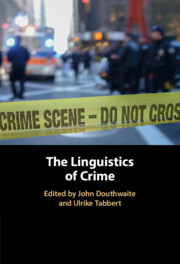Book contents
- The Linguistics of Crime
- The Linguistics of Crime
- Copyright page
- Contents
- Figures
- Tables
- Contributors
- 1 Editorial Introduction
- 2 The Metaphoric and Metonymic Conceptualisation of the Other
- 3 Prison Metaphors
- 4 Ideology in Mainstream Crime Fiction
- 5 A Critical and Stylistic Analysis of the Depiction of the Transnational Human Trafficking Victim in Minette Walters’ The Cellar
- 6 The Linguistic Construction of Political Crimes in Kurdish-Iraqi Sherko Bekas’ Poem The Small Mirrors
- 7 Stylistic Aspects of Detective Fiction in Translation
- 8 Transnational Adaptations of Sherlock Holmes
- 9 The Ethical Effects of Voice-Over Narration on a Victim Testimonial
- 10 Realising Betrayal
- 11 ‘Nossa Vida é Bandida’
- 12 Deviant Mind Style of a Schizophrenic Offender
- 13 Narrower or Broader Ground? The Role and Function of Metaphors in Legal Discourse
- 14 Condemning the Condemners
- 15 Ideology in Critical Crime Fiction
- Index
- References
11 - ‘Nossa Vida é Bandida’
Reading Rio Prohibited Funk from a CDA Perspective
Published online by Cambridge University Press: 05 January 2023
- The Linguistics of Crime
- The Linguistics of Crime
- Copyright page
- Contents
- Figures
- Tables
- Contributors
- 1 Editorial Introduction
- 2 The Metaphoric and Metonymic Conceptualisation of the Other
- 3 Prison Metaphors
- 4 Ideology in Mainstream Crime Fiction
- 5 A Critical and Stylistic Analysis of the Depiction of the Transnational Human Trafficking Victim in Minette Walters’ The Cellar
- 6 The Linguistic Construction of Political Crimes in Kurdish-Iraqi Sherko Bekas’ Poem The Small Mirrors
- 7 Stylistic Aspects of Detective Fiction in Translation
- 8 Transnational Adaptations of Sherlock Holmes
- 9 The Ethical Effects of Voice-Over Narration on a Victim Testimonial
- 10 Realising Betrayal
- 11 ‘Nossa Vida é Bandida’
- 12 Deviant Mind Style of a Schizophrenic Offender
- 13 Narrower or Broader Ground? The Role and Function of Metaphors in Legal Discourse
- 14 Condemning the Condemners
- 15 Ideology in Critical Crime Fiction
- Index
- References
Summary
Mayr investigates song lyrics (proibidão) glorifying gang leaders in Rio de Janeiro’s favelas. With her CDA approach and her use of Appraisal Theory she argues that proibidão, in fact, serves ideologically to recontextualise gang violence and legitimise favela criminals.
- Type
- Chapter
- Information
- The Linguistics of Crime , pp. 214 - 252Publisher: Cambridge University PressPrint publication year: 2023

